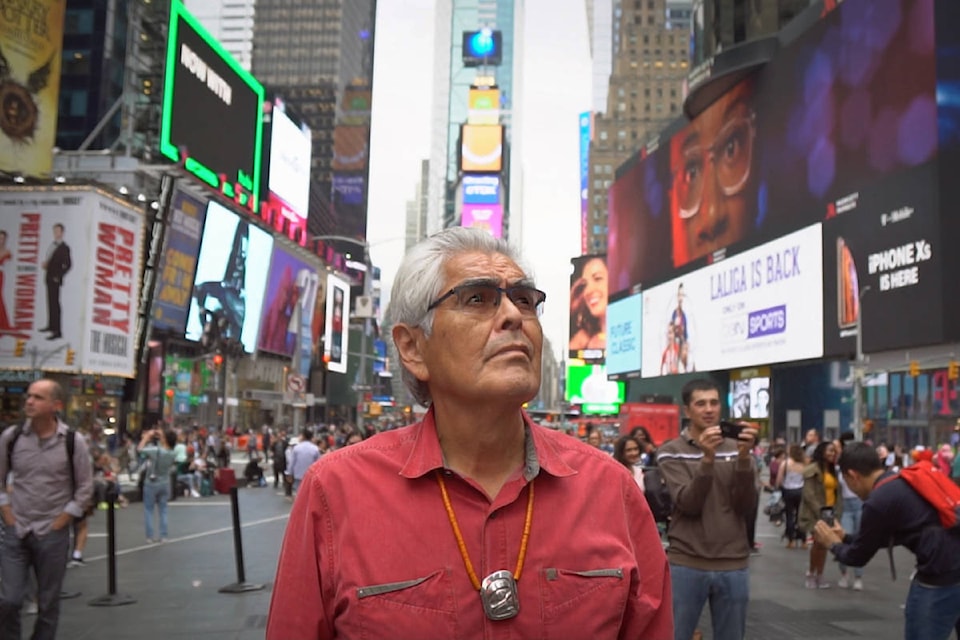“Can we imagine an image to start changing the direction?”
That is the question Haida artist Robert Davidson is seeking to answer in the new documentary Haida Modern. Directed by Charles Wilkinson, the film is set to debut at the Vancouver International Film Festival (VIFF) on Oct. 1. It will showcase the influence that Davidson’s work has had in sparking a revitalization of Haida art, and how he has brought a global lens to these Pacific islands and their works.
Davidson’s question is not an easy one, and as such certainly does not reveal a single answer. Davidson does identify key areas that he feels have had profound meaning for his culture however, starting with a distinct moment that took place 50 years ago.
| Robert Davidson painting. (Kevin Eastwood photo) |
Davidson was a key part of the undertaking to raise a totem pole in Old Massett in 1969. It had been more than a century since such an event had happened, during which time the totem poles in Old Massett had been taken down at the behest of missionaries.
READ MORE: Haida story headed to the international stage
Davidson explained how this was part of a systemic trend of the erasure of First Nations history and culture.
Haida art and culture were in a precarious position, and many elders were worried that aspects of their culture were close to being lost forever.
“I had no idea how removed we were from Canadian history. There was hardly anything mentioned about us,” Davidson said of his educational experience growing up.
Davidson was well practiced in the carving craft prior to taking on the task, but it wasn’t until the process started that he began to grasp the full significance of the endeavour.
“I offered to carve a totem pole, not knowing what I was committing to. Because I wasn’t brought up with cultural knowledge or history, I had no idea of the importance of ceremony in raising a totem pole,” Davidson said.
“For a few weeks leading up to the date of the pole raising, my grandparents hosted many meetings with the elders to work out what had to be done. That totem pole was to help the elders celebrate one more time in the way they knew how.”
| Robert Davidson painting. (Tina Schliessler photo) |
READ MORE: Haida animator wins first festival award for The Mountain of SG̱aana
The direction certainly changed after Aug. 22, 1969. It had been speculated that Davidson would be the last of the Haida carvers, but the totem pole raising led to a rebirth of Haida art that today sees it feature prominently on the world stage.
Now, with a global presence comes an opportunity to use it to enact change. Davidson is hoping to address a major issue threatening Haida Gwaii, coastal B.C., and the world.
“If one totem pole can change the direction, what can we do to change the direction so more people are on board on how we can curb global warming?”
Davidson says the world is facing “dire straits” when it comes to climate change, and that there is not much time left before the problem becomes irreversible.
“We don’t have the luxury to sit around and talk about it anymore. We have to find more ways to get people involved.”
| Robert Davidson in his studio. (Kevin Eastwood photo) |
To this end, the film details how renewed interest in Haida art has led to a rise in support and engagement with First Nations activists and causes, both environmental and otherwise.
“I feel the role of the artist is to fill the void,” Davidson said. His work has been profound both in drawing in newcomers to Haida culture, and strengthening the resolve of the Haida people from within through renewed focus on art, ceremony and spirituality.
Charles Wilkinson, who previously directed the award winning documentary Haida Gwaii: On the Edge of the World, thought more context was needed to tell a more full story of the islands.
“What creates so much good on Haida Gwaii is this wonderful mix of the cultures; the modern progressive worldview that the newcomers bring, mixed with and heavily influenced by the ancient Haida worldview,” Wilkinson said.
“That worldview is what’s at the heart of it, the deep respect for the natural world and honouring traditional culture and valuing the elders in our midst.”
| Robert Davidson applies detail to his work. (Tina Schliessler photo) |
Wilkinson is also optimistic that Davidson’s environmental message will take hold.
“I think people will feel Robert’s message that things aren’t going particularly well in the Western culture right now, and that Robert believes we need to slow down and take a look at some of the insane decisions that are being made and act differently,” Wilkinson said. “And that revolves around respect for the natural world in particular.”
Haida Modern was shot in a number of locations, including many in the United States. Wilkinson said it was exciting to see such interest in Davidson’s, and Haida work as a whole, in places experiencing the art for the first time.
“It’s so great to see people in Texas coming to an art gallery to look at art from a North Coast Indigenous artist, and just be blown away by the subtlety and the beauty of it.”
Haida Modern will debut at the VIFF on Oct. 1, with a second showing scheduled for Oct. 11.
Alex Kurial | Journalist
Alex Kurial
Send Alex email
Like the Haida Gwaii Observer on Facebook
Follow us on Twitter
